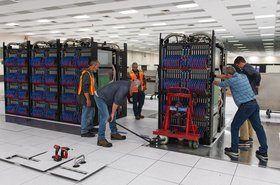A US Senator has proposed amending the National Defense Authorization Act for Fiscal Year 2022 to set environmental and resiliency targets for the Department of Defense's data centers.
Nevada Democrat Senator Catherine Cortez Masto this week submitted the amendment as part of a wider amendment put forward by fellow Democrat Senator Jack Reed.
If enacted, the amendment would see the Secretary of Defense sign off on developing a power usage effectiveness (PUE) target for each DoD data center, based on its location, age, and other factors.
Equally, a water usage effectiveness (WUE) target would be set for each site, along with other water and energy efficiency metrics where necessary. Renewable power would be sought out, as would the potential of using battery storage.
The Secretary would also set a resiliency and a facility availability target for the data centers. All of these metrics would also cover facilities owned or operated by third-party contractors.
New data centers would have to meet standards in all these areas to be able to be established.
As part of the amendment, the Secretary would have 180 days to conduct an inventory of all the data centers used by the Department of Defense. This would include the date on which the data center was established, the date of the most recent capital investment in new power, cooling, or compute infrastructure, and the total average annual power use.
It also calls for "an inventory of any data centers for which meeting such targets could more efficiently be achieved by transferring the workloads of such centers to private facilities, and a business case for meeting such targets in that manner."
Such an inventory would be based on the definition of a data center as set out by the Office of Management of Budget. This definition is controversial - or at least as controversial as a description of a data center can be.
Back in 2018, the OMB's definition of data centers included almost anything with a server that provides services (whether in a production, test, staging, development, or any other environment). A room containing only print servers, routing equipment, switches, security devices (such as firewalls), or other telecommunication components, was not a data center.
That meant that the US government operated some 12,062 data centers. But a year later, it narrowed the definition to exclude some 4,500 'data centers' from the agencies' inventories.
The Government Accountability Office has criticized this move, saying it stops agencies from focusing on thousands of server rooms and closets - all of which waste power, cost money, and serve as cyber security risks.
But by either agencies' metric, the DoD has been poor at tracking and killing its own data centers. Under the Data Center Optimization Initiative (DCOI), and the preceding Federal Data Center Consolidation Initiative (FDCCI) and Federal Information Technology Acquisition Reform Act (FITARA), government agencies across the nation have closed thousands of data centers.
By 2021, the Government Accountability Office found that the US government had closed 6,250 data centers, saving $6.24 billion. But it added that the DoD was the worst-performing agency under the DCOI year after year, despite setting up a specific data center closure team.
“Since 2010, the DoD has closed over 1,400 data centers with hundreds more scheduled to close as systems continue to migrate to more effective, efficient and secure environments,” Danielle Metz, the DoD deputy chief information officer for information enterprise, said this August during ATARC’s digital transformation event.
“In late 2018, my office focused on cloud adoption in data center consolidation with 14 defense agencies and field activities, as part of DoD’s IT reform activities. We started this initiative in earnest with a goal of moving 960 individual systems to targeted cloud environments, and closing 60 data centers by the fourth quarter of fiscal 2021. Today, we have completed 80 percent of our goal on target and have action plans in place to complete the remaining 20 percent by next year.”
In October, the DoD said that it operated 12 core data centers, and hoped to halve that number by 2028. It also operates around 250 data processing nodes, and hopes to cut a few hundred off that figure - all by shifting to the cloud.
The Department of Defense has been engaged in a long, and tumultuous, shift to the cloud. The military's cloud email and business software services are handled by General Dynamics IT, which resells Microsoft Office 365 - but the contract was delayed by more than a year and reduced in scope due to legal challenges by other contractors.
It still had a better fate than the Joint Enterprise Defense Infrastructure contract, a $10bn deal once set to handle most of the DoD's compute needs. But after Microsoft won in 2019, rival Amazon Web Services launched an aggressive legal and public fight, claiming that President Donald Trump had blocked it from winning the contract.
The veracity of AWS' claim was never truly tested in court, with the DoD dropping JEDI in July 2021. It now plans to award contracts to both AWS and Microsoft Azure under the Joint Warfighter Cloud Capability contract.
Senator Masto has received campaign contributions from both Microsoft and Amazon, as well as third-place cloud provider Google (via its Alphabet parent company).








